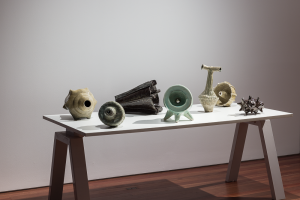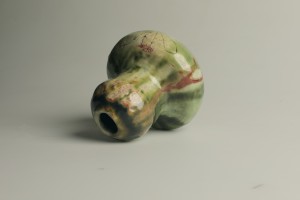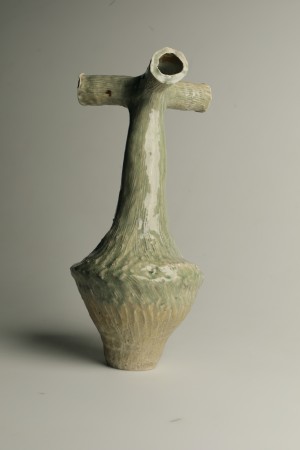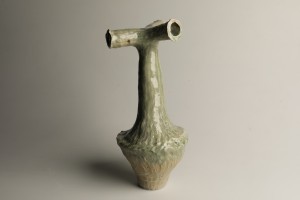

copper attachments, 2023, stoneware and copper glaze

sensing a vacuum, 2023, porcelain and copper glaze

three pronged vacuum, 2023, raku and celadon glaze

three pronged vacuum, 2023, raku and celadon glaze
Elements such as iron, copper, calcium, cobalt, or lithium at a raw level can be transposed in multiple ways, from enabling technology and metabolisms, they are biological building blocks and in our batteries and computers or electrical circuits - these minerals, metals, crystals and rocks, are also geologies and landscape.
The surface of ‘copper attachments (study of gourd shape)’ is a constellation of elements interacting with each other. A recipe comprising of feldspar, calcium carbonate, silica, kaolin and copper carbonate, the colour and textural variations derive from uneven thickness and irregularities that are picked up on by the oxygen and by-product gases that move about in the kiln’s atmosphere.
copper attachments (study of gourd shape) tells a story, its inconsistent colours trace how copper attached or detached with the atmosphere and other gases and minerals. Through colour, texture, translucency or opacity, the work is an exploration of how ceramic glazes can offer an aesthetic perspective on the minerals inside and around us.
⁂
Claire de Carteret (b. Gosford/Darkinjung country) lives and works on unceded Gadigal land. She is an emerging ceramicist interested in technology, minerals and listening. Her recent research uses traditional ceramic processes, glaze technology and underwater field recordings to investigate the physical and conceptual possibility of resonance. In 2021 she graduated from UNSW with a double BA in Fine Arts and Politics and is currently completing her honours at Sydney College of the Arts.